
Deposition Date
2014-08-03
Release Date
2014-10-01
Last Version Date
2024-10-23
Entry Detail
PDB ID:
4U8H
Keywords:
Title:
Crystal Structure of Mammalian Period-Cryptochrome Complex
Biological Source:
Source Organism:
Mus musculus (Taxon ID: 10090)
Host Organism:
Method Details:
Experimental Method:
Resolution:
2.80 Å
R-Value Free:
0.27
R-Value Work:
0.20
R-Value Observed:
0.20
Space Group:
P 41


